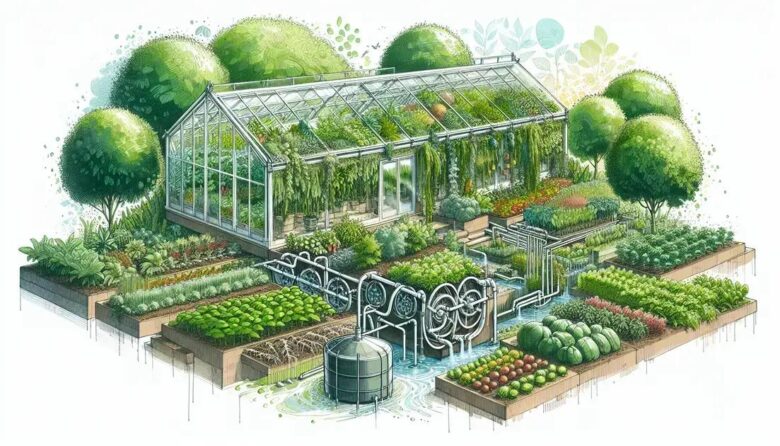Rainwater collection systems in greenhouses are crucial for sustainability, providing a natural water source and reducing water bills, with simple installation steps like gutters, tanks, and drip irrigation ensuring efficient water use while maintaining plant health.
Rainwater collection in greenhouses is an amazing step towards sustainable agriculture. Imagine using natural resources to cultivate a thriving permaculture. Curious about how it works?
what is rainwater collection and its importance
Rainwater collection is the process of capturing and storing rain for later use. In a world where water scarcity is an increasing concern, this method contributes significantly to sustainable resource management, especially in agriculture. By setting up a rainwater collection system, individuals and businesses can reduce their dependency on municipal water supplies.
Why is it important? Rainwater collection helps in minimizing the impact on local water bodies and reduces the risk of floods by managing stormwater runoff effectively. Additionally, it provides an alternative water source for irrigation in greenhouses, supporting the growth of crops with minimal environmental impact.
Incorporating rainwater collection into greenhouse management fosters sustainable permaculture by utilizing a natural resource that would otherwise go to waste. This approach not only conserves water but also enhances soil health by preventing erosion and maintaining local water cycles.
Benefits of Using Rainwater
Harvested rainwater is ideal for plants as it is free of chemicals found in tap water, like chlorine. This natural and soft water contributes to healthier plant growth. Besides, it helps save money on water bills and reduces carbon footprints, making it an eco-friendly choice for greenhouses.
how to set up a rainwater collection system
Setting up a rainwater collection system in your greenhouse can greatly enhance its sustainability. Begin by determining the optimal location for your system, ensuring that it can capture sufficient rainwater from your greenhouse roof. Install gutters and downspouts that direct water into a storage tank or barrel.
Select a filtration system to purify the rainwater before it’s used for irrigation. This helps in removing debris and ensures the collected water is safe for plants. You can choose between screen filters, which remove larger particles, and more advanced filters for smaller impurities.
Consider a pump system to facilitate the flow of water from the storage to your irrigation lines. This ensures that your plants receive consistent watering regardless of the water table level. For flexibility, a gravity-fed system can be a cost-effective alternative if your greenhouse configuration allows it.
Finally, incorporate measures to prevent overflow during heavy rainfall. An overflow pipe that directs excess water away can keep your system in good working order.
benefits of rainwater collection for permaculture
Rainwater collection offers numerous advantages for permaculture systems. It provides a sustainable source of water that supports plant growth while reducing stress on local water supplies. By capturing and storing rainwater, permaculture practitioners can ensure that their plants receive natural nourishment, as rainwater is free from salts and chemicals.
Enhancing Soil Health is another key benefit, as rainwater helps maintain the natural balance of microorganisms in the soil. It prevents the buildup of salts that can occur when using treated municipal water. This natural balance enhances the productivity and resilience of plants.
Rainwater systems reduce runoff and erosion by capturing rainfall that would otherwise flow away. This not only preserves topsoil but also minimizes the impact on local waterways by preventing sediment and nutrient pollution. Implementing rainwater collection thus aligns with the core principles of permaculture, which focus on ecological stewardship and sustainable resource management.
By relying on locally sourced water, permaculture systems can become more resilient to climate change and drought conditions. Adaptable systems that utilize rainwater are better equipped to maintain productivity during dry spells, supporting consistent harvests regardless of external conditions.
integrating rainwater systems with greenhouse designs
Integrating rainwater systems with greenhouse designs involves strategic planning to make the most of natural rainfall. Start by evaluating the layout of your greenhouse to identify optimal locations for capturing water. Rooftops are ideal for collecting rain, so installing gutters along the edges of the roof can efficiently direct water to collection tanks.
Placement of storage tanks should be close enough to minimize pumping distances but not obstruct daily greenhouse operations. Consider using slimline tanks for tight spaces or modular designs that fit the garden layout. The tanks should have connections ready for plumbing lines leading into the greenhouse for irrigation purposes.
Having a well-designed distribution system is key. This includes pipes and hoses that transport water from tanks to plants. Drip irrigation methods can be particularly effective, delivering water directly to the plant roots and ensuring efficient use of the collected rainwater.
Integrate automation systems like timers or soil moisture sensors that trigger watering based on the needs of the plants. This reduces manual intervention and optimizes water usage. Lastly, ensure that all materials used are resistant to weather elements and UV exposure, prolonging the lifespan of the system.
common challenges and solutions in rainwater collection
Rainwater collection systems can present several challenges, but understanding these can help develop effective solutions. One common issue is debris accumulation in gutters and downspouts. Regular maintenance, such as cleaning and installing gutter guards, can prevent blockages and ensure efficient water flow.
Water contamination is another concern, particularly from bird droppings or roof materials. Using first flush diverters can help by discarding the initial flow of water that might carry contaminants. Additionally, installing effective filtration systems is crucial to maintain clean water for irrigation.
Overflow management during heavy rain is essential to prevent system damage. Incorporating overflow pipes or channels can direct excess water into safe runoff areas or secondary storage tanks. This prevents water wastage and potential damage to the collection system.
Many systems face limited storage capacity, which can be addressed by combining multiple tanks or using modular designs to expand as needed. Planning based on average rainfall levels will help ensure sufficient water storage for dry periods.
Finally, weather resilience is vital. Using durable materials that can withstand extreme weather conditions helps extend the life of a rainwater collection system. Regular system checks and updates also keep the system running efficiently.
real-life examples of successful rainwater collection
There are numerous inspiring examples of successful rainwater collection systems that demonstrate their potential. In a small urban farm, owners implemented a comprehensive roof catchment system. They used it to collect and store rainwater in large tanks, which helped them maintain a thriving vegetable garden even during dry seasons.
An eco-friendly school in a drought-prone area incorporated rainwater harvesting into their sustainability curriculum. Students actively participate in maintaining the system, which provides water for gardens that supply fresh produce for the school cafeteria, exemplifying community engagement and resourcefulness.
Another noteworthy project is a commercial greenhouse that installed an advanced rainwater system, integrating filtration and storage solutions. This system significantly reduced their reliance on municipal water while also cutting down on costs, ultimately improving their profitability.
In rural areas, smallholder farmers have made great strides by using rain collection systems to support crop irrigation. By capturing and utilizing rainwater efficiently, these farmers have increased their yields, demonstrating the transformative power of rainwater harvesting on agricultural productivity.
Embracing The Benefits of Rainwater Collection
By integrating rainwater collection systems, both small and large scales can see significant benefits. These systems help conserve water, reduce expenses, and promote sustainability in agriculture and beyond.
Whether in a home garden, commercial greenhouse, or active community projects, these solutions not only support plant growth but enhance ecological balance.
The inspiring real-life examples show how rainwater collection can be a game-changer. From urban farms to rural farming practices, harnessing rainwater helps maintain productivity in various climates.
By addressing challenges with effective solutions, rainwater harvesting continues to pave the way for sustainable development. Consider implementing these systems to unlock their full potential and contribute to a greener future.
FAQ – Common Questions About Rainwater Collection and Permaculture
What are the main benefits of rainwater collection for greenhouses?
Rainwater collection provides a sustainable water source, reduces water bills, and supports healthier plant growth due to its chemical-free nature.
How do I prevent debris buildup in my rainwater system?
Installing gutter guards and conducting regular maintenance checks can prevent the accumulation of leaves and other debris.
Can I integrate rainwater systems into an existing greenhouse?
Yes, by adding gutters and storage tanks appropriately and ensuring proper distribution lines are set up for irrigation purposes.
How much rainfall do I need to effectively collect water?
The amount depends on your storage capacity and water needs, but even light rains can add up over time, effectively supporting irrigation efforts.
What are common challenges when using rainwater for irrigation?
Challenges include potential contamination, managing overflow, and ensuring enough storage, which can be mitigated with good planning and system design.
Are there any incentives or support for using rainwater harvesting systems?
Some regions offer incentives or rebates for sustainable water use practices, so it’s worth checking local resources or environmental grants.



